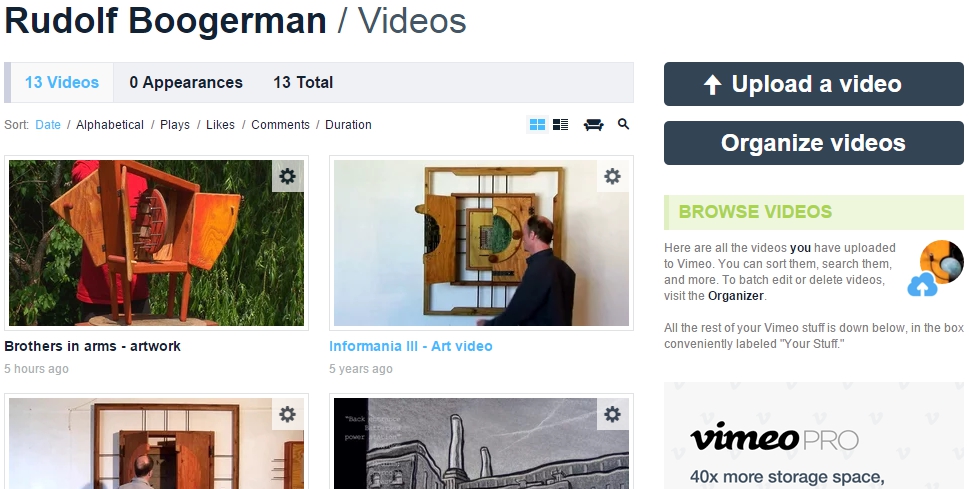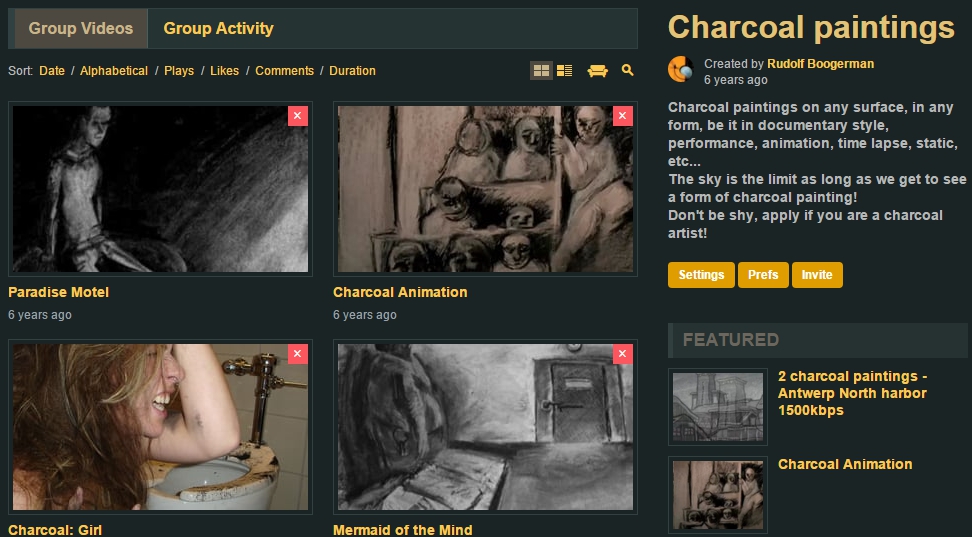 Updated 8 September 2016. Vimeo is to my mind one of the best video networks around because it has a high concentration of creative content providers. It is not like on YouTube where if you type “art video” in the search box, you get loads of music clips or ” the art of making jam“- type videos. On the contrary, on Vimeo you generally get what you ask and the quality is often better than on YouTube. That said, there is good quality on YouTube as well, no doubt about that, but it is harder to find in between the thousands of junk videos. As Vimeo is a much smaller network, good quality content gets a better chance and that is what I like about it. Like all networks, there are all sorts of subjects to be found.
Updated 8 September 2016. Vimeo is to my mind one of the best video networks around because it has a high concentration of creative content providers. It is not like on YouTube where if you type “art video” in the search box, you get loads of music clips or ” the art of making jam“- type videos. On the contrary, on Vimeo you generally get what you ask and the quality is often better than on YouTube. That said, there is good quality on YouTube as well, no doubt about that, but it is harder to find in between the thousands of junk videos. As Vimeo is a much smaller network, good quality content gets a better chance and that is what I like about it. Like all networks, there are all sorts of subjects to be found.
What is the secret of Vimeo’s success?
There are many reasons why Vimeo is successful in banning out the majority of junk video, and attracting serious video publishers, but I’m only going to mention a couple of them: One of them is that they do quality checks on the accounts. Secondly, you need to have a paid subscription if you want to post more then 5OOMB per week or upload more then 1 HD video weekly. This measure seems to scare off a lot of freeloaders, especially the sort that uploads badly compressed clones from TV shows and music clips (although you will find them here and there).
You can buy the Plus subscription which is only $60 a year (-minus 5 cents), you get 5GB per week storage and the compression quality is better than the free account.
The third reason is that even with the paid subscription, it is not allowed to upload commercial videos, except when you go for the Pro subscription ($159/year) which does allow commercial presentation videos.
Regarding the free and Plus accounts, note that Vimeo is about sharing good content, playing the system, i.e.: using loopholes to push commercial messages is rather tricky business because one offending video is enough to close down the account forever.
Collaboration between members
Apart from groups, Vimeo also has a lively projects section where members collaborate in all sorts of concepts. The groups also encourage collabaration between like minded souls. Perhaps this is the reason why you find so many visual artists and creatives in this network.
Options and video compression
The video compression is very reasonable on Vimeo and with the paid subscription it is even better.
Supported video formats:
There is no currently no list with allowed formats, but the safest way is to upload MP4 or MOV
Vimeo recommends the following compression settings:
- H.264 for the video codec (compression method).
- Frame rate: usually 29.97, but 24 and 25 are accepted as well.
- Size and bitrate:
640×480 for standard definition 4:3 video, 2Mbs – 5Mbs bitrate
640×360 for standard definition 16:9 video, 2Mbs – 5Mbs bitrate
1280×720 for 720p HD video, 5Mbs – 10Mbs bitrate
1920×1080 for 1080p HD video, 10Mbs – 20Mbs bitrate - Sound codec: AAC-LC (Advanced Audio Codec)
- Sound sample rate: 48 kHz
- Audio quality: constant bitrate f 320 kbps.
I have nothing to add to those recommendations, they are just fine as they are. If your video ends up to heavy to upload, try a maximum bitrate of 5Mb
The interface
The interface is clean and easy to understand and there are video tutorials to help you on your way:
There are many options on the network. You can join groups, create groups, setup your own channel, install widgets and, as I said, participate in projects with other members, etc …
Vimeo Groups
Groups are mini networks where videographers can contribute videos regarding a specialized subject, while channels are similar to YouTube channels where you upload your own videos.
Projects are often used as a test bed for all sorts of ideas.
The video player: has more or less the same options as most other networks.
Help section
There are FAQs, video tutorials and the forum. Some help sections could be better: for instance, I ended up having to send an email to know how to get out of a group because it was not covered in the FAQ nor the forum. But the response was quick and personal, not a standard answer, so you feel that there are real people behind this network.
Video On Demand
There is also a Video On Demand option (VOD). Vimeo takes care of transcoding into various formats for desktops and mobiles. For this service, you pay $159/year and they only take 10% commission + transaction costs on everything you sell.
There is just one problem with this offer, though: if Vimeo finds your content inappropriate, or someone complains about your content, your account can be closed without warning. An artist lost her VOD channel with over 400 videos (which took months to build up), just because the artwork was deemed unsuitable, without any further information given. Also the protection of video is wobbly on Vimeo, various download apps can simply download you videos.
Various ways to display Vimeo videos on your site
There are 3 main ways to publish your Vimeo videos on your site:
- Embedding single video. View the tutorial How to embed a video from Vimeo
- Embedding a video player (Hubnut). View the tutorial https://www.miracletutorials.com/howto-vimeo-hubnut/
- Placing thumbnails to videos (Montage). View the tutorial How to create a Vimeo Montage widget
Compared with the other video portals, this network gets a 5/.5 star from me!



This information is now rather dated due to Vimeo’s launch of its “PRO” services.
Yes, alas it is. Still, they have a huge community base of creative users, let’s just hope the marketing boys remain a small percentage.
Hello
I am looking for a platform where my violin and piano students can send a smartphone recording of their weekly lessons.
Also I would like to compile all there best performances in a file where all my students can log in and listen to each others performances in place of their year end recital.
Is vimeo a suitable platform for this?
1. If so how do my students submit their recordings?
2. How do I set up an account to receive their recordings
3. How do I set up a file with all their best performances.
Hi Debbie,
1 & 2: If you want to work with Vimeo, you will need to set up a group. Then, all your students need to create a vimeo account and then you can add them to the group. After that, they can upload their videos and add it to the group. All linked videos are automatically added to the list of videos in the group.
3. On your personal account you can setup a playlist with the best performances you select.
However, there is a restriction on the maximum upload per account. The free account has a maximum upload capacity of 500mb per week and a total storage maximum of 5GB. If each students needs more, there is the Plus plan of $72 per year, which gives 5GB upload per week and maximum storage 250GB.
I hope this helps? Let me know if you have further questions.
Rudolf+++
Vimeo group account is the best option for you, IMO. Personally using the same.